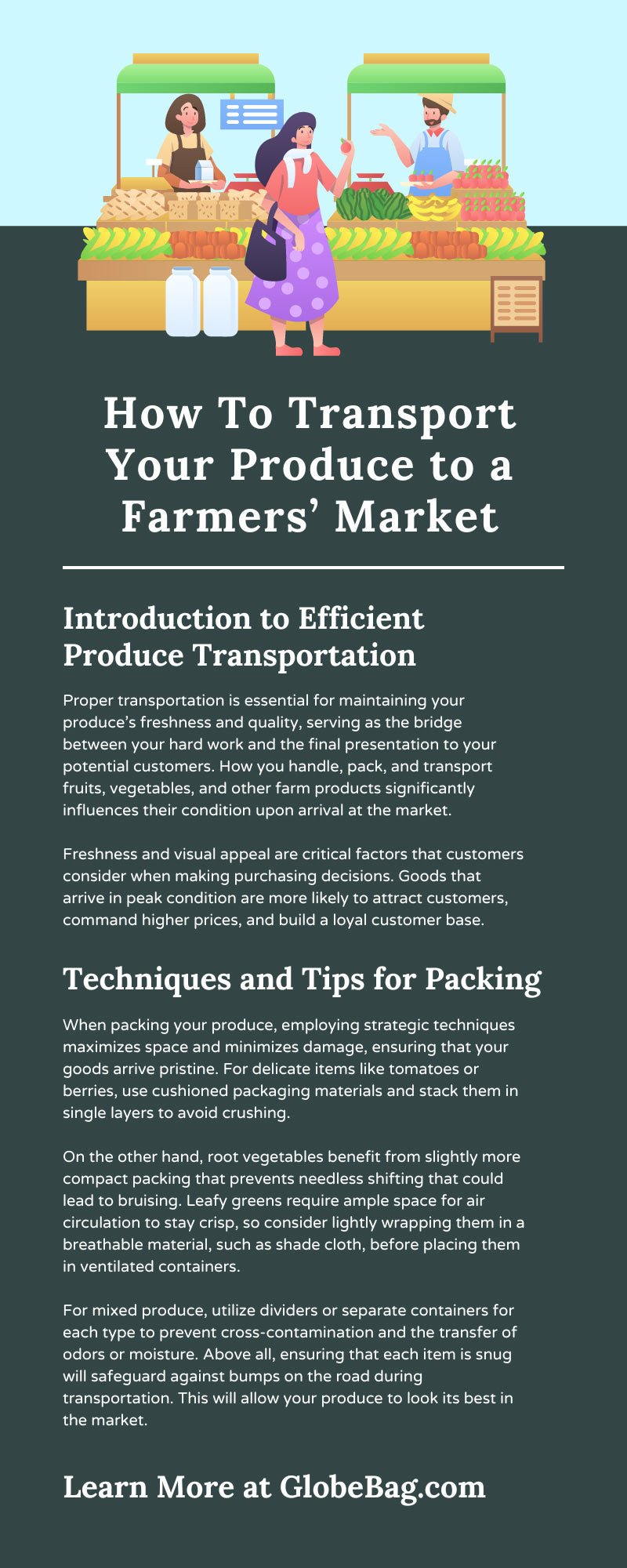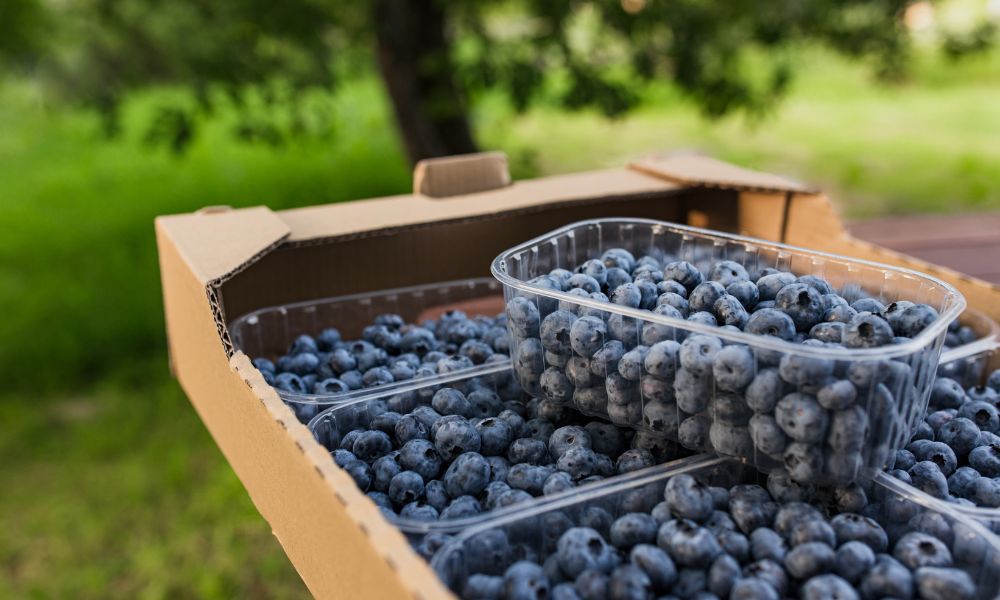Transporting your produce to a farmers’ market is a critical step in ensuring the freshness and quality of your goods upon their arrival. An efficient and careful transportation process significantly impacts the appeal of your produce to potential customers, influencing their buying decisions. Use this guide to learn how to transport your produce to a farmers’ market and preserve its quality.
Introduction to Efficient Produce Transportation
Proper transportation is essential for maintaining your produce’s freshness and quality, serving as the bridge between your hard work and the final presentation to your potential customers. How you handle, pack, and transport fruits, vegetables, and other farm products significantly influences their condition upon arrival at the market.
Freshness and visual appeal are critical factors that customers consider when making purchasing decisions. Goods that arrive in peak condition are more likely to attract customers, command higher prices, and build a loyal customer base.
Selecting the Right Packaging for Your Produce
Selecting the right packaging for your produce involves carefully balancing durability, cost-efficiency, and sustainability. High-quality, affordable packaging options, such as ventilated crates and boxes consisting of recycled materials, minimize environmental impact and ensure your products’ safety and freshness during transit.
These containers provide adequate ventilation, which is crucial for preventing moisture buildup and spoilage. Additionally, using reusable or recyclable packaging solutions reflects a commitment to environmental stewardship, enhancing your brand’s image among eco-conscious consumers.
Techniques and Tips for Packing
When packing your produce, employing strategic techniques maximizes space and minimizes damage, ensuring that your goods arrive pristine. For delicate items like tomatoes or berries, use cushioned packaging materials and stack them in single layers to avoid crushing.
On the other hand, root vegetables benefit from slightly more compact packing that prevents needless shifting that could lead to bruising. Leafy greens require ample space for air circulation to stay crisp, so consider lightly wrapping them in a breathable material, such as shade cloth, before placing them in ventilated containers.
For mixed produce, utilize dividers or separate containers for each type to prevent cross-contamination and the transfer of odors or moisture. Above all, ensuring that each item is snug will safeguard against bumps on the road during transportation. This will allow your produce to look its best in the market.
Temperature Control
Maintaining the correct temperature during transportation is pivotal in preserving your produce’s shelf life and freshness. Different types of produce require specific temperature ranges to remain vibrant and prevent spoilage.
For example, leafy greens thrive in cooler temperatures, typically between 55 and 65 degrees Fahrenheit. This range maintains their crispness and prevents wilting. In contrast, fruits like pomegranates tolerate warmer temperatures, generally around 85 degrees Fahrenheit. This allows them to retain flavor and texture without accelerating ripening too quickly.
Utilizing tools like insulated containers, refrigerated trucks, or even portable thermometers helps monitor and control the temperature, ensuring that each type of produce is in its ideal environment.
Managing Moisture and Preventing Spoilage
Controlling moisture levels during transportation is essential to prevent spoilage and maintain your produce’s visual appeal. Employing materials like absorbent pads that you place under or around sensitive berries or leafy greens effectively draws away excess moisture. It mitigates the risk of mold growth and decay.
Ventilated packaging plays a critical role, allowing air to circulate freely around the produce and preventing the accumulation of condensation, which is detrimental to freshness. Furthermore, silica gel packets in closed containers help absorb residual moisture, ensuring that humidity levels within the packaging are manageable.
Choosing the Right Transportation Vehicles
Choosing the right vehicle is critical in ensuring your produce reaches the market in optimal condition, and the decision should rely on the volume and type of produce you’re transporting. Using small, insulated vans that offer temperature control is ideal for small to medium volumes, especially for delicate or premium products. These vehicles provide careful handling and precise temperature regulation, which are essential for preserving the quality of sensitive items.
For larger volumes of hardier produce, refrigerated trucks provide an efficient solution capable of transporting vast quantities while maintaining the necessary cool environment. These trucks are particularly beneficial when transporting produce over longer distances, as they keep large quantities of goods fresh. For very short distances, using unrefrigerated vehicles is suitable for certain types of produce, especially if the transit time is minimal and the weather conditions are favorable.
Loading Strategies for Efficiency and Safety
Loading your produce into your vehicle requires careful planning and execution to optimize space, prevent damage, and ensure a safe journey to the market. Evaluate the layout of your vehicle and plan the arrangement of goods to transport your produce to the farmers’ market safely.
Heavier items should be at the bottom of the load, while lighter, more delicate items should be on top to prevent crushing. Distribute the weight evenly across the vehicle to maintain balance and stability during transit, which is crucial for safety when navigating turns or uneven roads.
Also, utilize the right equipment, such as pallets and straps, to further secure the produce. Pallets elevate the produce off the vehicle floor, maintaining airflow and preventing moisture damage. This is particularly important for refrigerated transport.
Strapping down the containers prevents shifting, which leads to bruised or damaged goods. Ensure that all items are easily accessible for unloading upon arrival, with the items intended for immediate sale or those most susceptible to damage near the doors. Creating an inventory list of loaded items is a valuable practice that helps track what you load.
Route Planning and Timing
Careful route planning and timing are critical components in ensuring your produce reaches the market as quickly as possible. By meticulously planning the most efficient route, you’ll significantly reduce transit times. This will minimize the exposure of your produce to potentially harmful conditions during transport, such as excessive heat or prolonged confinement.
Equally important is the timing of your departure. Aiming to avoid peak traffic hours can prevent unnecessary delays that could compromise the freshness and quality of your produce. Early-morning or late-evening departures are often most effective in circumventing heavy traffic.
Unloading Techniques To Maintain Quality
Upon reaching the farmers’ market, how you unload your produce is paramount in maintaining its quality and visual appeal. Best practices for unloading begin with a structured approach. Prioritize removing delicate items first to prevent them from remaining under heavier produce and sustaining potential damage.
Use gentle hands and proper equipment, such as crates or trolleys, to transfer goods from the vehicle to your stall, minimizing the chances of accidental drops or bruises. Additionally, consider the immediate placement of temperature-sensitive items into shade or cool storage to preserve freshness, especially during warmer weather.
Considering Display and Presentation
The art of displaying your produce is critical in attracting customers and encouraging sales. A key to effective presentation is using high-quality packaging as part of your display strategy. Consider choosing packaging that preserves your produce’s integrity and freshness and enhances its visual appeal.
For instance, a string of onions looks visually appealing and remains in good condition when you use your onion bags in bulk. Arrange your products in a way that makes them easily accessible and visually pleasing, using tiered displays or color coordination to draw the eye.
Upon your arrival and setup at the farmers’ market, your transportation of goods is complete. Use this guide to make the process easier and keep your produce in great shape for your customers.

